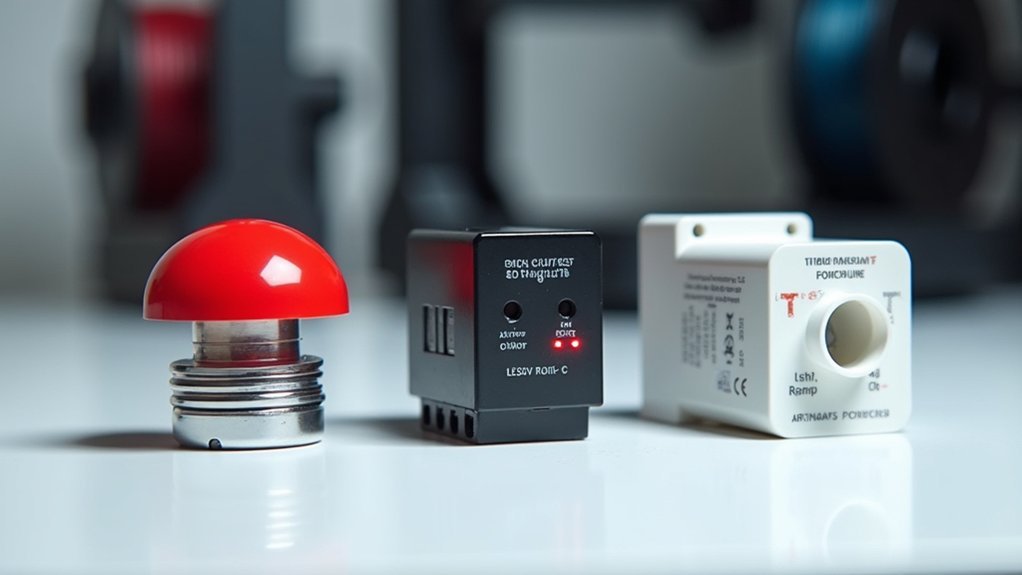You’ve invested in a quality 3D printer, but have you considered what happens when something goes wrong? Fire hazards in 3D printing aren’t just theoretical risks – they’re real dangers that can destroy your equipment, workspace, and potentially your home. While proper maintenance and monitoring help, you’ll need reliable emergency shut-off solutions as your last line of defense. The right combination of hardware and clear safety markings could be what saves you from disaster.
Mxuteuk 22mm Stainless Steel Emergency Stop Push Button Switch (MXU-DT-JH)
The Mxuteuk 22mm Emergency Stop Push Button Switch stands out as an industrial-grade solution for makers who need reliable emergency controls on their 3D printing setups. You’ll get a latching switch with both normally closed and normally open contacts, handling up to 10A AC or 3A DC at voltages from 12-220V. The stainless steel construction provides IP65 waterproof protection, making it suitable for workshop environments. Installation’s straightforward with its 22mm mounting hole and adjustable design for panels up to 6mm thick. The switch includes three terminals for versatile wiring configurations, letting you integrate it into various printer control circuits for immediate shutdown capability.
Best For: Makers and 3D printer enthusiasts who need a reliable, industrial-grade emergency stop switch for their workshop setups with versatile electrical configurations and durable construction.
Pros:
- Versatile electrical specifications with dual contact types (NC/NO) and wide voltage range (12-220V) suitable for various printer control circuits
- Robust stainless steel construction with IP65 waterproof rating makes it ideal for workshop environments
- Easy installation with 22mm mounting hole and adjustable design for panels up to 6mm thick
Cons:
- Limited to 3A DC current rating which may restrict use with high-power 3D printer components
- Package only includes one switch without additional mounting hardware or wiring accessories
- Relatively large button size (31.8 x 46.8mm) may not fit compact printer enclosures or control panels
Emergency Shut Off Sign Stickers for Powered Machinery (4 Labels)
Emergency shut-off sign stickers prove invaluable when you’re operating multiple 3D printers or managing a makerspace where quick identification of safety controls becomes critical during emergencies. These 2×1-inch heavy-duty vinyl labels clearly mark disconnect points, helping you and first responders locate shut-off switches instantly during fire hazards or equipment malfunctions.
You’ll appreciate their weatherproof construction that resists fading and abrasion in workshop environments. The commercial-grade adhesive sticks firmly to metal, plastic, and galvanized steel surfaces on your 3D printer frames and electrical panels. Installation takes seconds—simply peel and stick wherever you’ve placed emergency controls. At 4.5 stars from customer reviews, they’re an affordable safety investment for your printing setup.
Best For: Makerspace operators, workshop managers, and industrial facility supervisors who need to clearly mark emergency shut-off points on 3D printers, machinery, and electrical equipment for quick identification during emergencies.
Pros:
- Heavy-duty vinyl construction with weatherproof properties resists fading, abrasion, and harsh industrial conditions
- Quick peel-and-stick installation works on multiple surfaces including metal, plastic, and galvanized steel
- High visibility design helps both operators and first responders quickly locate emergency shut-off points during critical situations
Cons:
- Small 2×1-inch size may not be visible enough for larger industrial facilities or from greater distances
- Some customers have expressed concerns about the price point for basic vinyl stickers
- Limited to 4 labels per pack which may require multiple purchases for larger operations
10 Pack Emergency Shut-Off Warning Safety Stickers (6×2 Inches Self Adhesive Vinyl)
When you’re operating multiple 3D printers in a makerspace, educational facility, or production environment, clear emergency shut-off identification becomes critical for safety. The YIKIADA 10-pack emergency shut-off stickers provide highly visible 6×2 inch markers that help anyone quickly locate power switches during emergencies.
You’ll appreciate the waterproof vinyl construction that resists wear and moisture, ensuring reliable performance in various environments. Installation couldn’t be simpler—just clean the surface, peel, and stick. The strong adhesive bonds securely while remaining removable without leaving marks, allowing you to reposition labels as needed.
These red and white stickers work effectively on electrical panels, power strips, and circuit breakers near your 3D printing equipment.
Best For: Operators of multiple 3D printers, makerspaces, educational facilities, and production environments who need clear emergency shut-off identification for enhanced safety protocols.
Pros:
- Waterproof vinyl construction resists wear and moisture for reliable indoor and outdoor use
- Simple installation process with strong adhesive that removes cleanly without leaving marks
- Highly visible 6×2 inch red and white design enables quick emergency switch location
Cons:
- Limited to 10 stickers per pack which may not be sufficient for larger facilities
- Standard size may not fit all equipment configurations or available mounting spaces
- Red and white color scheme might not comply with specific industry safety color requirements
Factors to Consider When Choosing Emergency Shut-Off Solutions for 3D Printers
When selecting emergency shut-off solutions for your 3D printer, you’ll need to evaluate several critical factors that directly impact safety and functionality. Your choice must account for power rating requirements, available installation space, response time capabilities, and environmental protection standards. You’ll also need to decide between manual and automatic systems based on your specific printing environment and operational needs.
Power Rating Requirements
Electrical compatibility forms the foundation of any reliable emergency shut-off system for your 3D printer. You’ll need to match the shut-off switch’s rated voltage with your printer’s power supply, which typically ranges from 12V to 220V depending on your model. Don’t overlook current ratings—your emergency switch must handle your printer’s maximum current draw, usually around AC 10A or DC 3A, to guarantee safe operation without component failure.
Undersized switches create fire hazards and won’t protect your equipment effectively. Check your printer’s specifications carefully, including peak current demands during heating cycles. Select switches with ratings that meet or exceed these requirements. This electrical matching prevents switch burnout, guarantees reliable emergency stopping, and maintains the safety protection you’re installing the system to provide.
Installation Space Constraints
Space limitations dictate your emergency shut-off switch selection just as much as electrical specifications. You’ll need to measure your installation area carefully, ensuring the mounting hole diameter accommodates standard 22mm emergency stop buttons. Check your panel thickness—most switches require surfaces no thicker than 6mm for proper installation.
Consider the overall switch dimensions when planning placement. Standard emergency buttons typically measure 31.8 x 46.8mm maximum, so verify this fits your designated space comfortably. Don’t compromise on accessibility for size constraints—position the switch within easy operator reach for quick emergency response.
If you’re working in dusty or humid environments common to 3D printing setups, prioritize switches with IP65 protection ratings while still meeting your space requirements.
Response Time Capabilities
Beyond physical fit comes the critical matter of how quickly your emergency shut-off system responds when seconds count. Response time capabilities directly determine whether you’ll minimize damage or face catastrophic printer failure during overheating or mechanical malfunctions.
Latching emergency stop buttons offer the most reliable immediate power interruption, activating within milliseconds of being pressed. You’ll need systems that don’t hesitate or delay when fault detection occurs. High-visibility indicators enhance your ability to locate and activate shut-off mechanisms instantly during emergencies.
Your chosen solution must remain accessible within regulation-required distances from your equipment, ensuring you can reach it quickly. Consider durability factors too—your emergency system won’t help if dust, moisture, or temperature fluctuations have compromised its functionality when you need it most.
Environmental Protection Standards
When selecting emergency shut-off solutions, you must guarantee they meet stringent environmental protection standards that safeguard both your workspace and personnel. Choose devices constructed from non-toxic materials that won’t release harmful substances during normal operation or system failure. You’ll need equipment with proper waterproof ratings like IP65 to protect against moisture and dust infiltration that can compromise functionality.
Install durable labels and signage made from fade-resistant, abrasion-proof materials to maintain visibility and regulatory compliance. Consider your facility’s environmental conditions, including temperature extremes and chemical exposure, when positioning shut-off systems. These factors directly impact device reliability and performance. Meeting environmental protection standards isn’t just about compliance—it’s essential for minimizing legal complications and enhancing overall facility safety where 3D printing operations occur.
Manual Vs Automatic
Choosing between manual and automatic emergency shut-off solutions requires evaluating your facility’s specific operational needs and risk tolerance. Manual systems offer lower upfront costs and simpler installation, making them budget-friendly for smaller operations. However, they’re slower to respond since they require your physical intervention, potentially compromising safety during critical moments.
Automatic systems react instantly to hazardous conditions through sensor inputs, providing superior protection for your equipment and facility. They’ll integrate seamlessly with existing safety systems, offering real-time monitoring and alerts. While you’ll face higher initial costs and more complex installation requiring professional assistance, automatic solutions deliver enhanced safety and can prevent costly fire damage. Consider your budget, facility size, and acceptable risk levels when making this decision.
Cost Vs Safety
While emergency shut-off solutions require upfront investment, you’ll find that prioritizing safety delivers substantial long-term value compared to cutting corners on protection systems. High-quality latching push button switches provide reliable power disconnection when seconds matter most. You can minimize costs with simple solutions like well-placed emergency shut-off stickers, which cost little compared to potential medical bills or equipment damage from printer fires.
Clear, visible markers reduce your response time during emergencies, saving lives and property. Though durable materials like heavy-duty vinyl or stainless steel switches cost more initially, they’ll last longer and reduce replacement expenses. Remember, cheaper options might compromise effectiveness and violate safety regulations, creating higher risks. Balance cost considerations carefully—your safety investment today prevents catastrophic expenses tomorrow.
Frequently Asked Questions
How Often Should I Test My 3D Printer’s Emergency Shut-Off System?
You should test your emergency shut-off system monthly to guarantee it’s working properly. Regular testing helps identify potential failures before they become dangerous, keeping your equipment and workspace safe from electrical hazards.
Can Emergency Shut-Off Switches Be Installed on Any 3D Printer Model?
You can install emergency shut-off switches on most 3D printer models, but you’ll need to take into account your printer’s electrical specifications, available space, and wiring compatibility to guarantee proper integration.
What’s the Average Response Time for Emergency Shut-Off Systems to Activate?
You’ll typically see emergency shut-off systems activate within 0.1 to 2 seconds, depending on the type. Mechanical switches respond fastest, while thermal sensors take longer to detect temperature changes and trigger shutdown.
Do Emergency Shut-Off Solutions Void My 3D Printer’s Warranty?
Installing emergency shut-off solutions typically won’t void your printer’s warranty if you don’t modify the printer’s internal wiring or components. However, you should check your warranty terms and consider consulting your manufacturer first.
Should Emergency Shut-Off Switches Cut Power to Heated Components Only?
You shouldn’t limit emergency switches to heated components only. Complete power cutoff guarantees maximum safety by stopping all printer functions, preventing potential electrical fires from motors, electronics, or wiring beyond just heating elements.





Leave a Reply